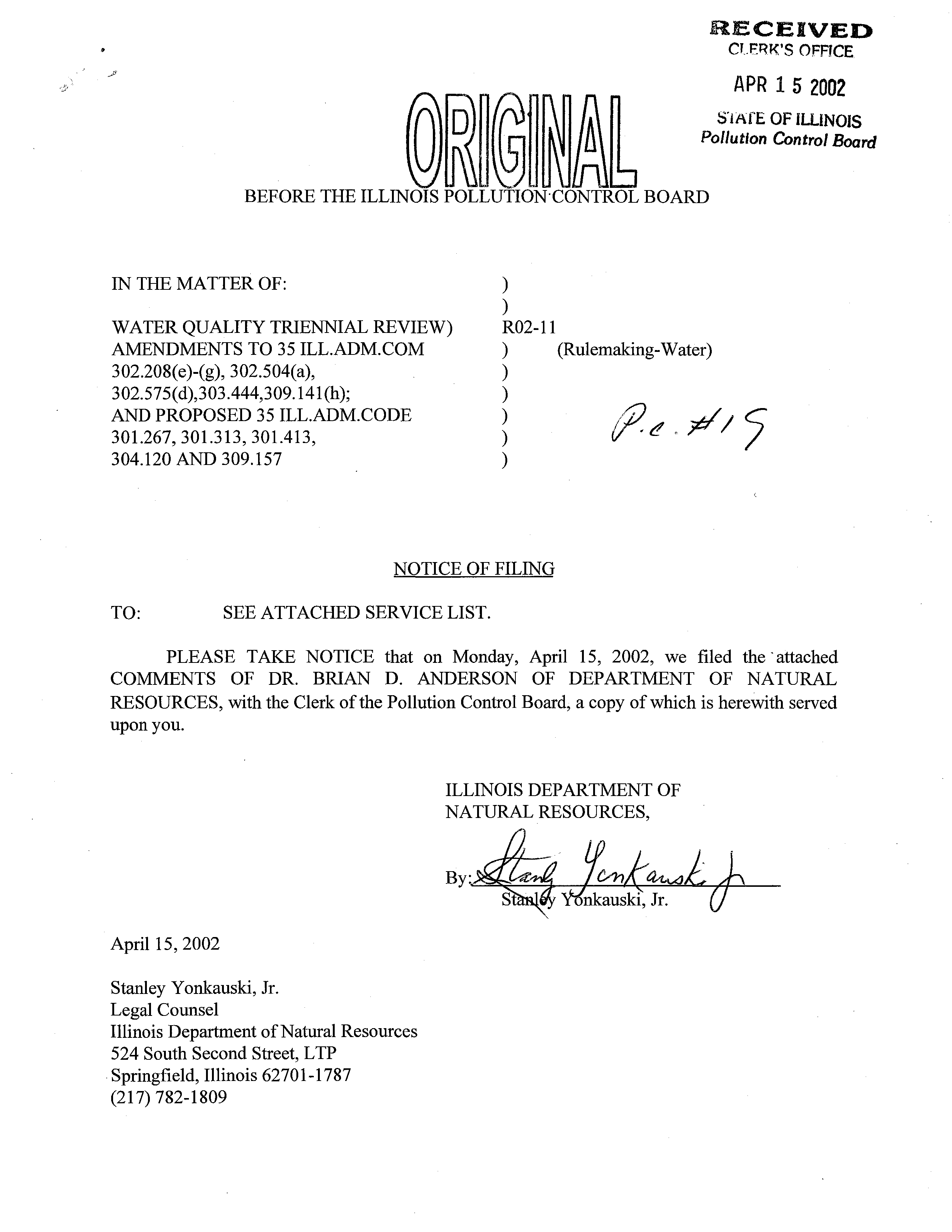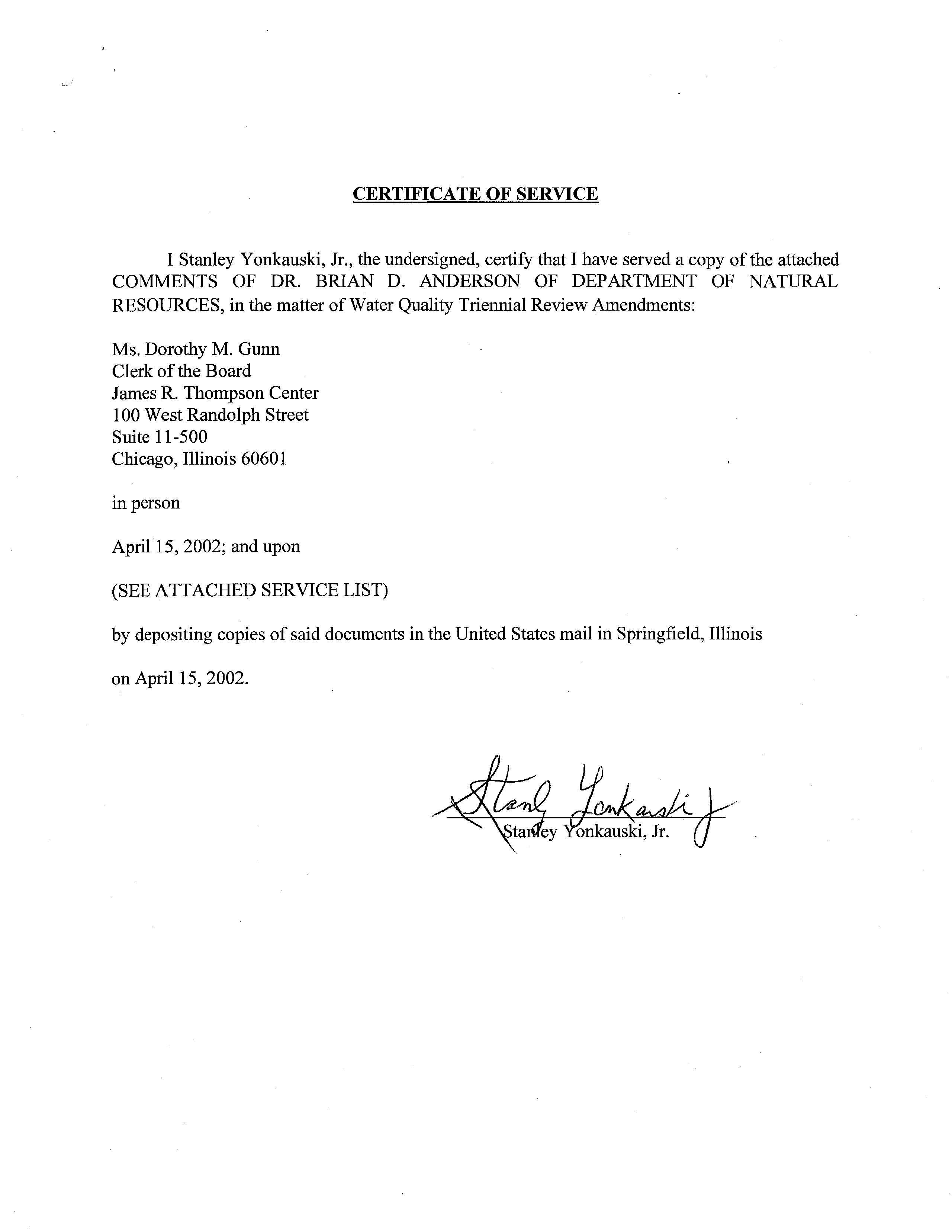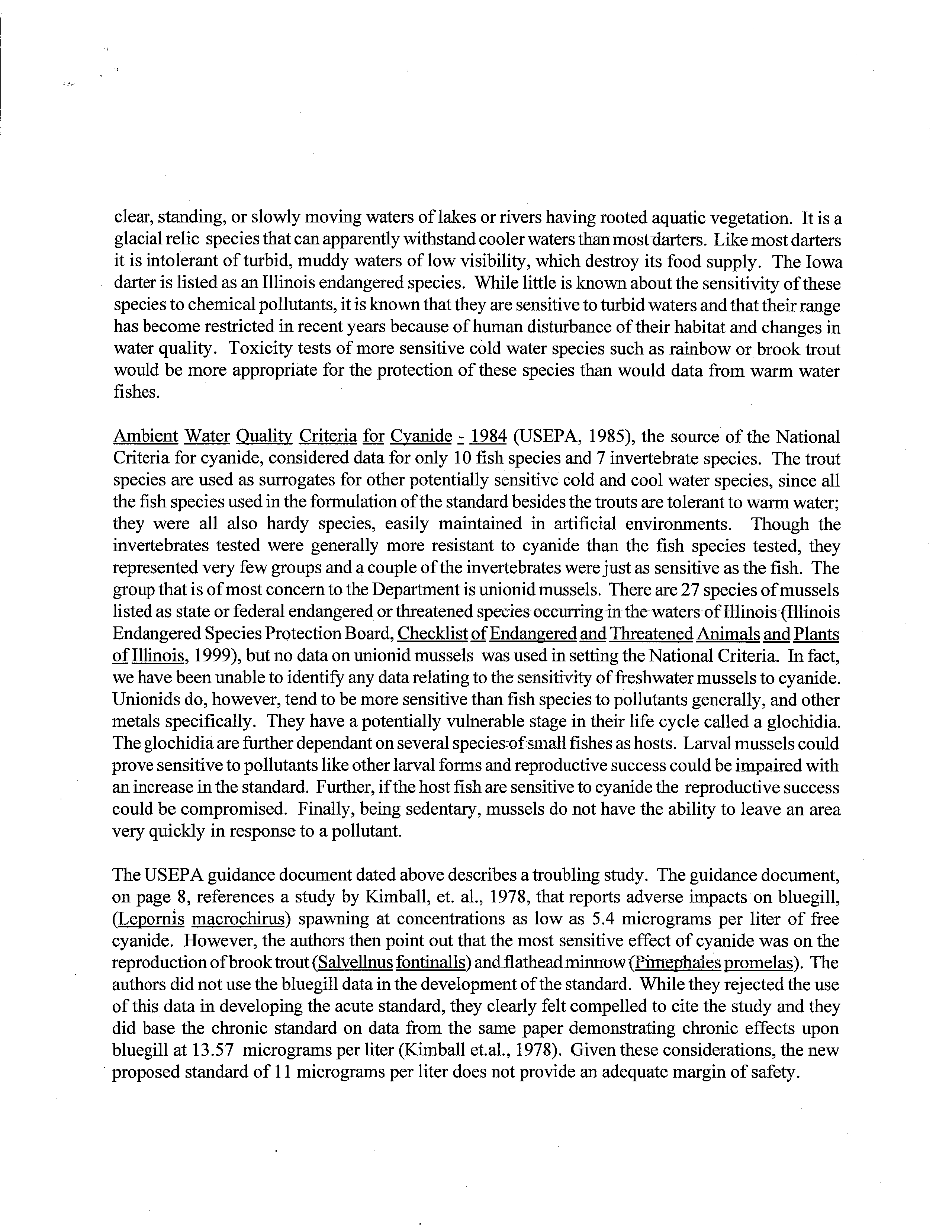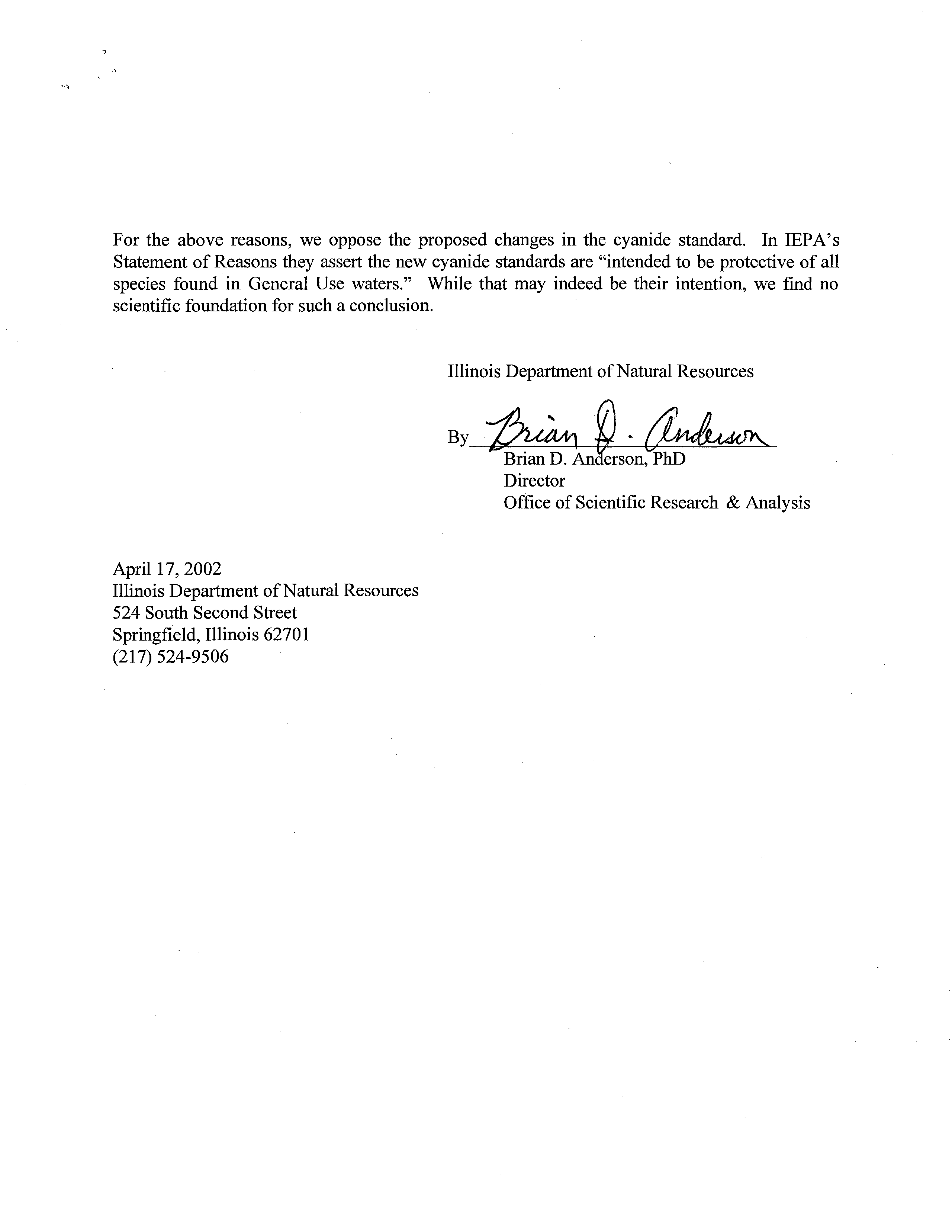RECEKVED
CLFRI’S OFFICE
L~PR1 5 2002
~J~~J
Pollution
Control
Board
BEFORE THE ILLINOIS POLLUTIONCONTROL BOARD
IN THE MATTER OF:
WATER QUALITY TRIENNIAL REVIEW)
AMENDMENTS TO 35 ILL.ADM.COM
302.208(e)-(g), 302.504(a),
302.575(d),303.444,309.141(h);
AND PROPOSED 35 ILL.ADM.CODE
301.267, 301.313, 301.413,
304.120 AND
309.157
NOTICE OF FILING
TO:
SEE ATTACHED SERVICE LIST.
PLEASE TAKE NOTICE that on Monday, April 15, 2002, we filed the attached
COMMENTS OF DR. BRIAN D. ANDERSON OF DEPARTMENT OF NATURAL
RESOURCES, with the Clerk of the Pollution Control Board, a copy ofwhich is herewith served
upon you.
ILLINOIS DEPARTMENT OF
NATURAL RESOURCES,
April
15,
2002
Stanley Yonkauski,
Jr.
Legal Counsel
Illinois Department ofNatural Resources
524
South Second Street, LTP
Springfield, Illinois 62701-1787
(217) 782-1809
)
)
R02-1 1
)
(Rulemaking-Water)
CERTIFICATE OF SERVICE
I Stanley Yonkauski, Jr., the undersigned, certify that I have served a copy ofthe attached
COMMENTS OF DR. BRIAN D. ANDERSON OF DEPARTMENT OF NATURAL
RESOURCES, in the matter of Water Quality Triennial Review Amendments:
Ms. Dorothy M. Gunn
Clerk ofthe Board
James R. Thompson Center
100 West Randolph Street
Suite 11-500
Chicago, Illinois 60601
in person
April15, 2002; and upon
(SEE ATTACHED SERVICE LIST)
by depositing copies ofsaid documents in the United States mail in Springfield, Illinois
on April
15,
2002.
~ \~taI~eyonkauski, Jr.
~
fltro/ aoard
BEFORE THE ILLINOIS POLLUTION CONTROL BOARD
IN THE MATTER OF:
)
)
WATER QUALITY TRIENNIAL REVIEW)
R02-1 1
AMENDMENTS TO 35 ILL. ADM. CODE
)
(Rulemaking-Water)
302.208(e)-(g), 302.504(a),
)
302.575(d),
303.444, 309.141(h);
)
AND PROPOSED 35 ILL. ADM. CODE
)
301.267, 301.3 13, 301.413,
)
304.120AND309.157
)
COMMENTS OF THE ILLINOIS DEPARTMENT OF NATURAL RESOURCES
The Illinois Environmental Protection Agency has proposedraising both the chronic and the acute
cyanide standard. The proposal would raise the weak acidic chronic standard from 5.2 micrograms
per liter to 11 micrograms per liter and the weak acidic acute standard-from 22 to 49 micrograms per
liter. The stated rational for this change is that the federal standard was developed using data for
cold water fish species (trout) and these species are not native to Illinois. While they may not be
native both the rainbow trout (Oncorhynchus mykiss) and brown trout (Salmo trutta) have been
stocked in Illinois and on occasion do reproduce in Illinois. The rainbow trout is known to have
reproduced in Devil’s KitchenLake, a reservoir in Williamson County (Lairdand Page, Non-Native
Fishes Inhabiting ~ Lakes .~jStreams .QfIllinois, 1996) and the brown trout mayhave reproduced
in Piscasaw Creek (also Laird and Page, 1996). The Department ofNatural Resources has invested
significant resources in developing it’s trout program and in stockingtrout in Illinois waters, and we
believe this fishery should be protected.
Illinois also has a number of fish species that could be considered cool water fishes, generally
restricted to the northern part of the state (such as the Blackchin shiner and the Iowa darter).
According to Scott and Crossman (Scott, W.B. and E.J. Crossman, Freshwater Fishes ofCanada.
Bull. 184, 1973), “clear, clean, weedy waters are essential for survival of the blackchin shiner and
it is especially noteworthy that it has been eliminated from the Iowa fauna during the last 25 years
and from Ohio waters since around 1950, presumablybecauseofthe drastic changes in water quality
and loss ofhabitat.” The authors report that the Iowa darter is an inhabitant of
clear, standing, or slowly moving waters of lakes or rivers having rooted aquatic vegetation. It is a
glacial relic species that can apparently withstand cooler waters thanrnostdarters. Likemost darters
it is intolerant ofturbid, muddy waters oflow visibility, which destroy its food supply. The Iowa
darteris listed as an Illinois endangered species. While little is known about the sensitivity ofthese
species to chemical pollutants, it is known that they are sensitive to turbid waters and that their range
has become restricted in recent years because ofhuman disturbance oftheir habitat and changes in
water quality. Toxicity tests of more sensitive cold water species such as rainbow or brook trout
would be more appropriate for the protection ofthese species than would data from warm water
fishes.
Ambient Water Quality Criteria
f.~
Cyanide: 1984 (USEPA, 1985), the source of the National
Criteria for cyanide, considered data for only 10 fish species and 7 invertebrate species. The trout
species are used as surrogates for other potentially sensitive cold and cool water species, since all
the fish species used in the formulation ofthe standardbesides the_trouts-are tolerantto warm water;
they were all also hardy species, easily maintained in artificial environments. Though the
invertebrates tested were generally more resistant to cyanide than the fish species tested, they
represented very fewgroups and a couple ofthe invertebrates were just as sensitive as the fish. The
group that is ofmost concernto the Department is unionid mussels. There are 27 species ofmussels
listed as state or federal endangered orthreatened species-occurringin the~atersofi1linois(fluinois
Endangered Species Protection Board, ChecklistQf Endangered
~
ThreatenedAnimals ~ Plants
~f
Illinois, 1999), but no dataon unionid mussels was used in setting the National Criteria. In fact,
we have been unableto identify any data relatingto the sensitivity offreshwater mussels to cyanide.
Unionids do, however, tend to be more sensitive thanfish species to pollutants generally, and other
metals specifically. They have a potentially vulnerable stage in their life cycle called a glochidia.
The glochidia are further dependant on several species~of:smallfishes as ho-sts. Larval mussels could
prove sensitive to pollutants like other larval forms and reproductive success could be impaired with
an increase in the standard. Further, if the host fish are sensitive to cyanide the reproductive success
could be compromised. Finally, being sedentary, mussels do not have the ability to leave an area
very quickly in response to a pollutant.
The USEPA guidance document dated above describes a troubling study. The guidance document,
on page 8, references a study by Kimball, et. al., 1978, that reports adverse impacts on bluegill,
(Lerornis macrochirus) spawning at concentrations as low as 5.4 micrograms per liter of free
cyanide. However, the authors then point out that the most sensitive effect of cyanide was on the
reproduction ofbrooktrout (Salvellnus fontinalls) andIlatheadniinnow (Pimephales promelas). The
authors did not usethe bluegill data in the development ofthe standard. While they rejected the use
of this data in developing the acute standard, they clearly felt compelled to cite the study and they
did base the chronic standard on data from the same paper demonstrating chronic effects upon
bluegill at 13.57 micrograms per liter (Kimball et.al., 1978). Given these considerations, the new
proposed standard of 11 micrograms per liter does not provide an adequate margin ofsafety.
For the above reasons, we oppose the proposed changes in the cyanide standard. In IEPA’s
Statement ofReasons they assert the new cyanide standards are “intended to be protective of all
species found in General Use waters.” While that may indeed be their intention, we find no
scientific foundation for such a conclusion.
Illinois Department ofNatural Resources
By___
Brian D. An erson, PhD
Director
Office of Scientific Research & Analysis
April 17, 2002
Illinois Department ofNatural Resources
524 South Second Street
Springfield, Illinois 62701
(217) 524-9506
R02-11
SERVICE LIST
Ms. Dorothy M. Gunn
Illinois Pollution Control Board
100 West Randolph Street
Suite 11-5000
Chicago, IL 60601
Albert Ettinger
Environmental Law & Policy Center
35 East Wacker Drive, Suite 1300
Chicago, IL 60601
James T. Harrington
Ross & Hardies
150 North Michigan Avenue, Suite 2500
Chicago, IL 60601
Katherine Hodge
Hodge & Dwyer
3150 Roland Avenue
P.O. Box 5776
Springfield, IL 62705
Marie E. Tipsord
Hearing Officer
Illinois Pollution Control Board
100 West Randolph, Suite 11-500
Chicago, IL 60601
Dennis Duffield
Department ofPublic Works
City of Joliet
921 E. Washington
Joliet, IL 60433-1267
Tom Muth
Fox Metro Water Reclamation District
682 State Route 31
Oswego, IL 60543
Sanjay Sofat
Illinois Environmental Protection Agency
1021 North Grand Avenue East
Springfield, IL 62794-9276
Margaret Haward Hedinger and Howard
1225 South Sexth Street
Springfield, IL 62703
Robert Messina
Illinois Environmental Regulatory Group
215 East Adams Street
Springfield, IL 62701
Irwin Polls
metropolitan Water Reclamation
District ofGreater Chicago
6001 West Pershing Road
Cicero, IL 60804
Mike Callahan
Bloomington Normal Water
Reclamation District
P.O. Box 3307
Bloomington, IL 61702-3307
Lisa Frede
Chemical Industry Council
9801 W. Higgins Road, Suite
515
Rosemont, IL 60018
Larry Cox
Downers Grove Sanitary District
2710 Curtiss Street
Downers Grove, IL 60515






